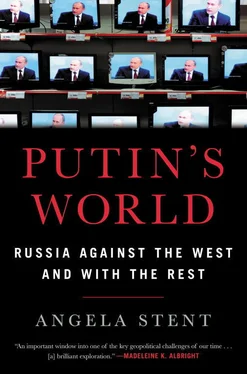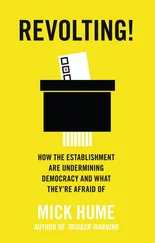Central to this effort to improve ties with Russia were the activities of Lieutenant General Michael Flynn, Trump’s first national security adviser. A former head of the Defense Intelligence Agency, he had the unusual experience of giving a lecture on leadership at the headquarters of the GRU—Moscow’s secretive military intelligence organization—in 2013. Flynn enjoyed his visit: “I was able to brief their entire staff. I talked a lot about the way the world’s unfolding. It was a great trip.” 20Flynn had grown disillusioned with the policies of the Obama administration in which he served, because he thought it underestimated the jihadist threat. He believed the US and Russia were natural allies in the fight against Islamic terrorism and that this should override all their other differences. He was eventually fired as head of the DIA by Obama. He returned to Russia in December 2015 to join the celebration of the tenth anniversary of RT, Russia’s main television foreign propaganda outlet. He was given a seat of honor next to Putin at the gala dinner. According to Flynn, Putin had “no respect for the United States leadership.” 21Once Trump had won the primaries, he chose Flynn as his national security adviser, and Flynn reached out to Russian ambassador Sergei Kislyak, a former physicist and arms control expert who had served in Washington for nine years. They met in Trump Tower with Jared Kushner, who sought to open a back channel to Russia.
Although Flynn was not yet in the White House, he clearly believed he had the authority to conduct foreign policy. On December 29, Obama announced that in retaliation for Russia’s interference in the 2016 election, he was expelling thirty-five suspected Russian intelligence operatives, imposing sanctions on Russia’s two leading intelligence agencies, and closing down two recreational diplomatic facilities that, so the government thought, were being used for purposes other than pure recreation. 22The next day, Putin appeared on television, and contrary to the expected tit-for-tat response, he announced that Russia would not expel thirty-five US diplomats but would wait to see how US policy toward Russia under Trump evolved. Moreover, in an unusual act of conviviality, he invited the children of the US embassy staff in Moscow to a New Year’s party in the Kremlin. Trump tweeted that Putin’s decision to wait is a “great move,” adding that he “always knew he was very smart.” 23
Why did Putin surprise the world and decline to activate the expected retaliation against the US? It subsequently emerged that Flynn called Kislyak numerous times after Obama announced the sanctions and reportedly assured him that if Russia did not retaliate, the Trump administration would reverse the sanctions once it was in office. There were two remarkable aspects to these calls. Firstly, it is illegal for private citizens to negotiate with a foreign power, and at that point Flynn was not a government official. Secondly—and perhaps more surprising—as a former DIA head, Flynn surely must have known that the Russian ambassador’s phone calls were being monitored and there would be a record of what he said. Indeed, one did not have to be a former DIA head to suspect this. Shortly after he became national security adviser, someone leaked details of the phone calls to the media. Flynn repeatedly denied that he had discussed sanctions with Kislyak, but after it emerged that he had lied to the vice president, Trump was forced to dismiss him—twenty-five days into the job. In December 2017, Flynn pleaded guilty to lying to the FBI and admitted he had discussed sanctions with Kislyak. 24
As more and more details emerged about contacts between the Trump campaign and Russians, questions about Trump’s own ties to Russia and his consistently positive view of Putin became increasingly tied to the major stories of 2016: Russia’s interference in the presidential election and possible collusion between Trump operatives and the Russians.
THE RUSSIAN INTERFERENCE CAMPAIGN
The Russian interference campaign was a multipronged strategy involving everything from sophisticated cyber operations to the exploitation of social media. It began in 2014 but burst into the public consciousness in 2016. On June 15, a hacker calling himself Guccifer 2.0 posted opposition research and donor documents stolen from the Democratic National Committee (DNC). A cybersecurity firm investigating the breach concluded that Russia was behind it, and later Guccifer was linked to the GRU. Then, in July—a day before the start of the Democratic National Convention—WikiLeaks posted 20,000 e-mails from DNC officials, some of which contained offensive remarks about Clinton’s rival Bernie Sanders. The leaks were intended to exacerbate tensions within the Democrats’ ranks and raise questions about the legitimacy of Clinton’s nomination. WikiLeaks’ founder, Julian Assange, holed up in the Ecuadorian embassy in London to avoid arrest on rape charges, held a personal grudge against Clinton. It was subsequently determined that Russians had given the stolen e-mails to WikiLeaks. 25In addition to a steady stream of leaked e-mails, state-run Russian media RT and Sputnik constantly denigrated Clinton, accusing her of corruption, calling into question her mental and physical health, and intimating she would “steal” the election from Trump.
As if that were not enough, Russia exploited social media to push disinformation to millions of Americans. It created thousands of bots (automated internet accounts) and paid internet trolls to spread false news. According to testimony by Twitter executives on October 2017, more than 30,000 Russia-linked accounts generated 1.4 million tweets during the final months of the campaign. 26Some of these posts showed telltale signs of faulty grammar and syntax (omitting definite articles, which is characteristic of the Russian language), but apparently no one thought these were generated by foreigners. According to the Mueller indictment, the Internet Research Agency coordinated the social media campaigns. Owner Yevgeny Prigozhin is quite resourceful. Not only do his restaurants feed visiting dignitaries and Kremlin bosses. He also owns Wagner, the major military contracting organization that sends mercenaries to fight in Ukraine, Syria, and elsewhere, and provides the Kremlin with plausible deniability in its hybrid wars. People who worked for the Internet Research Agency traveled to the United States to gather information on US political and social movements, and eventually remotely orchestrated dueling political rallies where opposing groups nearly came to physical blows. Of course, Putin has ridiculed the idea that Prigozhin was involved in hacking:
Do you really think that a person who is in the restaurant business, even if this person has some hacking opportunities and owns a private firm engaged in this activity—I do not even know what he does—could use it to sway elections in the United States or a European country? 27
Finally, the US Department of Homeland Security reported that Russia targeted presidential-election connected voting systems in at least twenty-one states, including key swing states, such as Florida, Ohio, and Pennsylvania. With the exception of Arizona and Illinois, which reported that their voting systems had been compromised, the Russian attempts to manipulate and sabotage voter data apparently failed. 28
This was an unprecedented attack on American democracy. During the Cold War, both the US and USSR had sought to interfere in each other’s domestic systems, and the Soviets had funded and promoted anti-American peace movements in Europe. But the scale of this coordinated campaign was qualitatively different from previous actions. In the age of social media and new technology, the possibilities for manipulation and influence are almost limitless. And the United States was caught completely off guard.
Читать дальше












